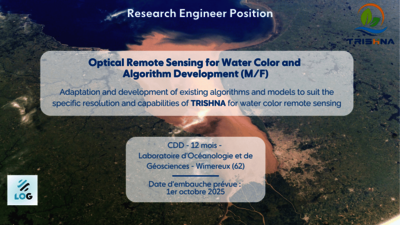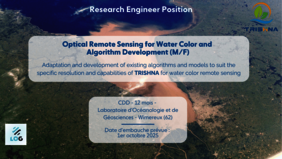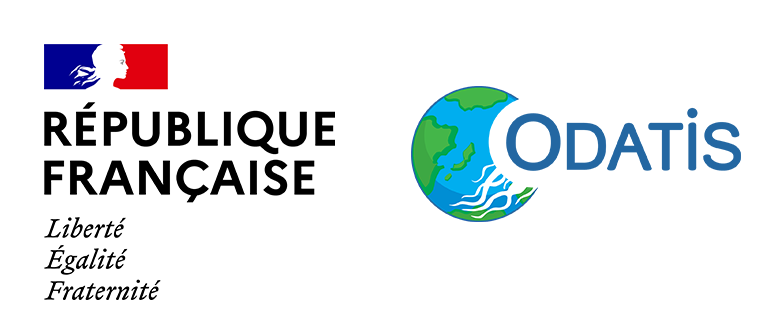Actualités
Liste des actualités
Offre de poste - Ingénieur Télédétection couleur de l'eau
Ce poste s'inscrit dans le cadre du projet TRISHNA-CLEC financé par TOSCA/CNES, qui vise à préparer la prochaine mission satellitaire TRISHNA dédiée à la surveillance de la couleur des océans.
Développé dans le cadre d'un partenariat franco-indien, la mission TRISHNA fournira des images haute résolution et haute fréquence de la surface terrestre dans les domaines solaire et infrarouge thermique. Le lancement du satellite est prévu pour 2026.
L'ingénieur de recherche contribuera à l'adaptation et au développement d'algorithmes et de modèles existants (notamment la correction atmosphérique, le masque d'eau WiPE, la correction des reflets solaires et les modèles de récupération des matières en suspension) afin de les adapter à la résolution et aux capacités spécifiques de TRISHNA pour la télédétection de la couleur de l'eau.
Pour postuler à ce poste, veuillez envoyer un CV détaillé, une lettre de motivation et une lettre de recommandation à :
- Cédric Jamet : cedric.jamet(at)univ-littoral.fr
- Charles Verpoorter : charles.verepoorter(at)univ-littoral.fr
La fiche de poste est détaillée ci-dessous, d'après le texte original en anglais:
Research Engineer Position – Optical Remote Sensing for Water Color and Algorithm Development (M/F)
- Laboratory: Laboratory of Oceanology and Geosciences – LOG
- Location: Wimereux, France
- Contract Type: Fixed-term Research Contract (CDD)
- Contract Duration: 12 months
- Expected Start Date: from October 1, 2025 (at the earliest)
- Working Hours: Full-time (35 hours/week)
- Salary: Starting from €2,847 gross/month, based on experience
- Required Education: PhD Desired Experience: 1 to 4 years
Project Overview
This position is part of the TOSCA/CNES-funded TRISHNA-CLEC project, which focuses on preparing for the upcoming TRISHNA satellite mission dedicated to ocean color monitoring. Developed through a French-Indian partnership, TRISHNA will offer high-resolution and high-frequency imagery of Earth’s surface in the solar and thermal infrared domains. The satellite is scheduled for launch in 2026.
The Research Engineer will contribute to the adaptation and development of existing algorithms and models (including atmospheric correction, the WiPE water mask, sun-glint correction, and suspended matter retrieval models) to suit the specific resolution and capabilities of TRISHNA for water color remote sensing.
Main Tasks and Responsibilities
• Process and analyze TRISHNA simulated imagery
• Adapt and develop satellite data processing algorithms
• Write and contribute to scientific articles
• Present research at TRISHNA-related and international conferences
Required Skills and Qualifications
Technical Skills:
• Strong programming skills (Matlab, Python, C)
• Experience in satellite remote sensing
• Knowledge of marine and/or atmospheric optics
• Proficiency in statistical data analysis
• Ability to write technical documentation and scientific reports
• Familiarity with specialized software in the field
Soft Skills:
• Autonomy and initiative
• Strong interpersonal and team collaboration skills
• Critical thinking and problem-solving mindset
• Attention to detail, adaptability, and discretion
• Capacity to report on activities and progress clearly
Language:
• Proficiency in English (from B2)
Work Environment
The position is based at the Laboratory of Oceanology and Geosciences (LOG) in Wimereux. LOG is a multidisciplinary research unit involved in oceanography and marine geoscience, combining field observation, experimental work, and modeling. The engineer will be part of the TELHYD team, which specializes in remote sensing and hydrodynamics.
Additional Information
• Working hours: Monday to Friday, 9 a.m. – 5 p.m. (on-site)
• Travel: Occasional travel in France or abroad may be required
• Contract: 12 months, renewable depending on project status
• Salary: Starting at €2,847 gross/month (adjusted based on experience)


